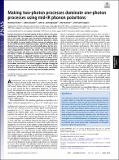Making two-photon processes dominate one-photon processes using mid-IR phonon polaritons
Author(s)
Rivera, Nicholas H.; Rosolen, Gilles D; Joannopoulos, John; Kaminer, Ido Efraim; Soljacic, Marin
Download13607.full.pdf (7.011Mb)
PUBLISHER_POLICY
Publisher Policy
Article is made available in accordance with the publisher's policy and may be subject to US copyright law. Please refer to the publisher's site for terms of use.
Terms of use
Metadata
Show full item recordAbstract
Phonon polaritons are guided hybrid modes of photons and optical phonons that can propagate on the surface of a polar dielectric. In this work, we show that the precise combination of confinement and bandwidth offered by phonon polaritons allows for the ability to create highly efficient sources of polariton pairs in the mid-IR/terahertz frequency ranges. Specifically, these polar dielectrics can cause emitters to preferentially decay by the emission of pairs of phonon polaritons, instead of the previously dominant single-photon emission. We show that such two-photon emission processes can occur on nanosecond time scales and can be nearly 2 orders of magnitude faster than competing singlephoton transitions, as opposed to being as much as 8-10 orders of magnitude slower in free space. These results are robust to the choice of polar dielectric, allowing potentially versatile implementation in a host of materials such as hexagonal boron nitride, silicon carbide, and others. Our results suggest a design strategy for quantum light sources in the mid-IR/terahertz: ones that prefer to emit a relatively broad spectrum of photon pairs, potentially allowing for new sources of both single and multiple photons. Keywords: two-photon processes; phonon polaritons; light–matter interactions; Purcell effect; nanophotonics
Date issued
2017-12Department
Massachusetts Institute of Technology. Department of PhysicsJournal
Proceedings of the National Academy of Sciences
Publisher
National Academy of Sciences (U.S.)
Citation
Rivera, Nicholas et al. “Making Two-Photon Processes Dominate One-Photon Processes Using Mid-IR Phonon Polaritons.” Proceedings of the National Academy of Sciences 114, 52 (December 2017): 13607–13612
Version: Final published version
ISSN
0027-8424
1091-6490